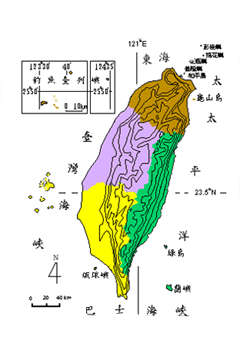The Geology of Taiwan

Relevant Websites
Reference
- Ho, Chun-sun, 1975: Tai-wan-di-zhi-gai-lun, Ministry of Economic Affairs, R.O.C., p. 118.
- Ho, Chun-sun, 1982: Tai-wan-di-ti-gou-zao-de-yan-bian, Ministry of Economic Affairs, R.O.C.,pp. 110.
- Lin, Chao-chi and Rji-tun Chou, 1974: Tai-wan-de-di-zhi, Zhong-yang-yue-gan, Vol. 6-12, pp. 109-118.
- Lin, Chao-chi and Jui-tun Chou, 1978: Tai-wan-di-zhi, Maw Chang Book Co., p. 450.
- Ho, Chun-sun, 1986: Tai-wan-di-zhi-gai-lun, Central Geological Survey, p. 164.
- Lin, Chao-chi, 1957: Tai-wan-di-xing, Tai-wan-sheng-tong-zhi-gao-juan One (Tu-di-zhi, Di-li-pian), Tai-wan-sheng-wen-xian-wei-yuan-hui-bain-ji-zu, Taipie, pp. 1-2.
Plate Tectonics
Taiwan is situated on the edges of the Eurasian and Philippine Sea plate. Huatung Longitudinal Valley marks the boundary line between the two plates: to the east of it is the Philippine plate and to the west is the Eurasian plate. The Philippine Sea plate keeps moving westward; when it hits the Eurasian plate it goes under the crust and becomes a subduction zone. The rising of Taiwan's Coastal Range (Hai-an Shan-mo) is a product of this plate movement.
Taiwan: An Island Arc
Taiwan was formed out of a geosyncline, a large, troughlike depression in the ocean floor containing masses of sedimentary and volcanic rocks, and is part of an island arc. This arc is short in length, high in altitude; located at the meeting point of the Ryukyu Island Arcs and Luzon Island Arcs, Taiwan is one of the few islands among the many in this East Asian region which arcs toward the Asian continent--that is, whose "convex surface" faces the mainland. Its geology is closely related to that of China.
Taiwan's Strata Conformation
The stratum of western Taiwan is principally made of marine rock sediment from the Tertiary Period (roughly 600 thousand to 65 million years ago) of the most recent geological era, the Cenozoic. The eastern part of the island, starting from the Central Mountain Range, is composed of metamorphic rock of the earlier Mesozoic and Paleozoic eras. Other areas, such as Tatun Shan in the north, the Coastal Mountain Range in the east and many outlying islets, are comprised of lava flow, agglomerates-masses of volcanic rock fragments fused by heat and the tuff of andesite (a fine-grained rock resembling granite).
Taiwan's strata are distributed in long and narrow strips, almost parallel to the island's axis. Metamorphic rock lies under the Central and Snow Mountain Ranges.
Sedimentary rock forms part of the island-wide piedmonts and coastal plains as well as the Coastal Mountain Range. As for igneous rock, Taiwan has more volcanic rock (which solidified from molten lava at or near the earth's surface) than plutonic rock (formed deep beneath the earth's surface). Dacite, a type of igneous rock, makes up the stratum of Tatun Volcano, Keelung Volcano and the Coastal Mountain Range while basalt, another kind of igneous rock, forms the Penghu Archipelago. So generally speaking, Taiwan has three geological zones divided by longitudinal faults: the Central Range, Western Piedmont and Eastern Coastal Mountain Range zones. The faults in Chin-shan, San-yi, and Chu-kou are within the zone of the Western Piedmont.
Tectonic Movements
Compression from the Philippine plate not only creates new mountains but also lifts the surface of Taiwan. On the average, Hengchun Peninsula and the Central Range rise 0.5 centimeters a year. Taiwan is a mountainous island, with more than 200 peaks of over 3,000 meters. These towering peaks with their steep slopes drastically contrast with the plains, which account for only 30% of the total land area. Obviously, in terms of geology, Taiwan is a very young and still developing island.
As a result of the high density of faults, Taiwan also experiences frequent earthquakes, especially in the east. The constant crustal movements unsettle the stratum in mountainous areas, which then tends to collapse in quakes or rainstorms. It was the movement of the Chelungpu and Shuangtung faults that caused the devastating Chi Chi or "9/21" earthquake in September of 1999.
Conclusion
Taiwan is an island with both geosyncline and island arc features. Its geosyncline environment, which has already gone through several transformations, turns out to be very complex. And its unique location at the meeting point of the Eurasian and Philippine plates brings about folds, faults and uplifting movements.
The strata of western flank of Central Range to the Taiwan Strait, are underlained by marine sedimental rock from the Tertiary period. The eastern flank of the Central Mountain Range toward the Pacific Ocean, is underlained by metamorphic rock of the earlier Mesozoic and Paleozoic eras. Other areas, such as Tatun Shan in the north, the Coastal Mountain Range in the east and many outlying islets, such as Penghu archipelago , are comprised of lava flow, agglomerates-masses of volcanic rock fragments fused by andesite and basalt.